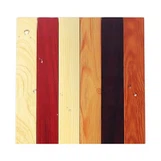Hey there! I'm a supplier of Marble Aluminum Panels, and I often get asked by customers how to estimate the quantity of these panels needed for a project. It can seem a bit tricky at first, but with the right approach, it's actually quite doable. In this blog, I'll walk you through the process step by step.
1. Measure the Area
The first thing you gotta do is measure the area where you plan to install the Marble Aluminum Panels. This is the foundation of your quantity estimation. You'll need to measure both the length and the height of the surface.
Let's say you're working on a wall. Use a tape measure to get the length from one end to the other. Make sure to measure along the base of the wall, and write down the measurement in feet or meters, depending on what you're used to. Then, measure the height from the floor to the ceiling.
Once you have these two measurements, multiply them together. For example, if the length of the wall is 20 feet and the height is 10 feet, the area of the wall is 20 x 10 = 200 square feet.
If you're dealing with a more complex surface, like a curved wall or a surface with multiple sections, you might need to break it down into smaller, more manageable shapes. Measure each section separately and then add up the areas.
2. Consider the Panel Size
Marble Aluminum Panels come in different sizes. The most common sizes are 4 x 8 feet, 5 x 10 feet, etc. But you can also get custom - sized panels if you need them.
When estimating the quantity, you need to divide the total area you measured in step one by the area of a single panel. For example, if your panel is 4 x 8 feet, the area of one panel is 4 x 8 = 32 square feet.
Using the 200 - square - foot wall example from above, divide 200 by 32. 200 ÷ 32 = 6.25. In this case, you'd need at least 7 panels because you can't buy a fraction of a panel.


3. Account for Waste
No matter how careful you are, there's always going to be some waste during the installation process. You might have to cut panels to fit around corners, doors, or windows. And sometimes, a panel might get damaged during handling or installation.
As a general rule of thumb, it's a good idea to add an extra 10% to 15% of the total quantity you calculated in step two to account for waste.
Let's go back to our example where we calculated that we need 7 panels. If we add 10% for waste, we calculate 7 x 0.1 = 0.7. Rounding up, we add 1 more panel. So, in total, we'd need 8 panels.
4. Factor in the Design and Layout
The design and layout of your project can also affect the quantity of panels needed. For example, if you're using a pattern that requires precise alignment, you might need to order extra panels to ensure you have enough to complete the pattern.
Also, if you're installing the panels in a diagonal or herringbone pattern, there will be more cutting and potentially more waste. In these cases, you might want to increase the waste factor to 15% or even 20%.
5. Check for Special Features
If your project has special features like Hollow Carved Aluminum Veneer or Wooden Aluminum Composite Panel accents, you'll need to calculate the quantity of these separately.
Measure the area where these special features will be installed and follow the same process as above to estimate the quantity. Keep in mind that these specialty panels might come in different sizes and have different waste factors.
6. Consult with a Professional
If you're still not sure about your quantity estimation, it's always a good idea to consult with a professional. An experienced installer or a project manager can give you valuable insights based on their past projects.
They can also help you with any technical aspects of the installation, like how to cut the panels properly and how to deal with any unexpected issues that might arise.
Conclusion
Estimating the quantity of Marble Aluminum Panels for a project isn't rocket science, but it does require some careful planning and calculation. By following the steps above, you can get a pretty accurate estimate.
If you're interested in Marble Aluminum Panel for your project, don't hesitate to reach out. We're here to help you with all your panel needs, from quantity estimation to installation advice. Contact us to start the procurement discussion and let's work together to make your project a success!
References
- Construction Estimating: Principles and Practices, Second Edition by Steven R. Bowling
- Building Construction Handbook, 6th Edition by Roy Chudley and Roger Greeno




